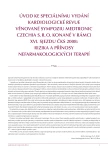Electromagnetic interference in patients with implants.
Authors:
MUDr. Jitka Vlašínová, Ph.D.
Authors place of work:
Interní kardiologická klinika LF MU a FN Brno
vlasinova@centrum. cz
Published in the journal:
Kardiol Rev Int Med 2008, 10(Mimořádné): 19-22
Summary
In the Czech republic was last year carried out 6 239 primoimplants pacemakers and 1 226 primoimplants cardioverter defibrillators. Electromagnetic interference is a risk of complications at the patiens with PM or ICD. It may cause of complete inhibition of the device. This can be the cause of syncope at the dependent patiens. Asynchronous stimulation without the perception of own heartbeat may cause malignant arhytmia or so called pacemaker tachycardia – rapid chambers stimulation leasing to the collapse of the circulation. At ICD it can lead to a false perception of tachycardia and inadequate shock therapy. The doctor should know this interference in order to learn the patient how to behave in normal life, which activities he doesn´t need to worry and what should be avoided. When considering the medical treatment it should always be evaluated the benefit of the patient and the risks.
Keywords:
electromagnetic interference - pacemaker - cardioverter defibrillator – inhibition – asynchronous pacing – inadequate therapy
Zdroje
1. Trikgano A, Blandeau O, Dále C et al. Reliability of electromagnetic filters of cardiac pacemakers tested by cellular telephone ringing. Heart Rhythm 2005; 2(8): 837-841.
2. Tandogan I, Ozin B, Bozbas H et al. Effects of mobile telephones on the function of implantable cardioverter defibrillators. Ann Noninvasive Electrocardiol 2005; 10(4): 409-413.
3. Francis J, Niehaus M. Interference between cellular tephones and implantable rhythm device: a review on recent papers. Indian Pacing Electrophysiol J 2006; 6(4): 226-233.
4. Lakshminarayan Y, Reddy PC. Effects of electromagnetic interference on implanted cardiac device and their management. Kardiol Rev 2007; 15 : 304-309.
5. Binggeli C, Riskli H, Ammann P et al. Induction oves and electromagnetic interference: What is the risk for patiens with implantable cardioverter defibrillators? J Cardiovasc Electrophysiol 2005; 16(4): 399-401.
6. Kolb C, Schmieder S, Lehmann G et al. Do airport metal detectors interfere with implantabl pacemakers or cardioverter-defibrillators? J am Coll Cardiol 2003; 41(11): 2054-2059.
7. Lo R, Mitrache A, Juan W, Cohen TJ. Electrocautery-Induced Ventricular Tachycardia and Fibrillation during Device Implantation and Explantation. J Invasive Cardiol 2007; 19(1): 12-5.
8. Lo R, Mitrache A, Juan W, Cohen TJ. Electrocautery-Induced Ventricular Tachycardia and Fibrillation during Device Implantation and Explantation. J Invasive Cardiol 2007; 19(1): 12-5.
9. Mangold JC, Izrael CW, Ehrlich JR. External cardioversion of atrial fibrillation in patiens with implanted Pacemaker or cardioverter - defibrillator systéms: a randomized comparison of monophasic and biphasic shock energy application. Eur Heart J 2007; 28(14): 1731-1738.
10. Martin E, Coman JA, Shellock FG et al. Magnetic resonance imaging and cardiac Pacemaker safety at 1,5-Tesla. J am Coll Cardiol 2004; 43(7): 1315-1324.
11. Naehle CP, Sommer T, Meyer C et al. Strategy for safe performance of magnetic resonance imaging on a patient with implantable cardioverter defibrillator. Pacing Clin Electrophysiol 2006; 29(1): 113-116.
12. Prashant N, Aiel R. Magnetic resonance Imaging in patiens with ICDs and Pacemakers. Indian Pacing Electrophysiol J 2005; 5(3): 197-209.
13. Kuffer R, Thamasett S, Volkmer B et al. New-generation lithotripters for treatment of patiens with implantable cardioverter defibrillator:experimental approach and review of literature. J Endourol 2001; 15(5): 479-484.
14. Sundar S, Symonds RP, Deehan C. Radiotherapy to patiens with artificial cardiac pacemakers. Cancer Treat Rev 2005; 31 : 474-486.
15. Hurkmans CW, Scheepers E, Springorum Bg, Uiterwaal H. Influence of radiotherapy on the lates generation of implantable cardioverter - defibrillators. Int J Radiat Oncol Biol Phys 2005; 63(1): 282.
16. Nemec J. Runaway Implantable Defibrillator-A Rare Complication of Radiation Therapy. Pacing Clin Electrophysiol 2007; 30(5): 716-718.
17. Lakkireddy D, Patel D, Ryschon K et al. Safety and efficacy of radiofrequency energy catheter ablation of atrial fibrillation in patiens with pacemakers and implantable cardiac defibrillators. Heart Rhythm 2005; 2(12): 1309-1301.
18. Schoeck AP, Mellion ML, Gilchrist JM, Christian FV. Safety of nerve conduction studies in patiens with implanted cardiac device. Muscle Nerve 2007; 35(4): 521-524.
19. Nagele H, Azizi M. Inappropriate ICD discharge induced by electrical interference from a physio-therapeutic muscle stimulation device. Herzschrittmacherther Elektrophysiol 2006; 17(3): 137-139.
20. MacPherson RD, Loo CK, Barrett N. Electroconvulsive therapy in patiens with cardiac pacemakers. Anaesth Intensive Care 2006; 34(4): 470-474.
Štítky
Dětská kardiologie Interní lékařství Kardiochirurgie KardiologieČlánek vyšel v časopise
Kardiologická revue – Interní medicína

2008 Číslo Mimořádné
- Není statin jako statin aneb praktický přehled rozdílů jednotlivých molekul
- Diagnostika osteoporózy v kontextu současných doporučení
- Antikoagulační léčba u pacientů před operačními výkony
Nejčtenější v tomto čísle
- Elektromagnetické interference u pacientů s implantáty
- Katetrizační ablace síňových tachyarytmií: které pacienty indikovat a jak o ně následně pečovat
- Intervenční kardiologie 2008: historické poznámky, současnost, trendy
- Léčba poruchy srdečního rytmu
